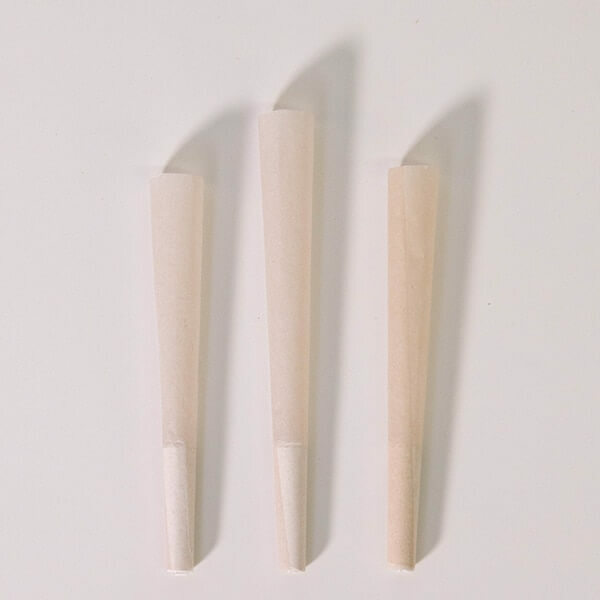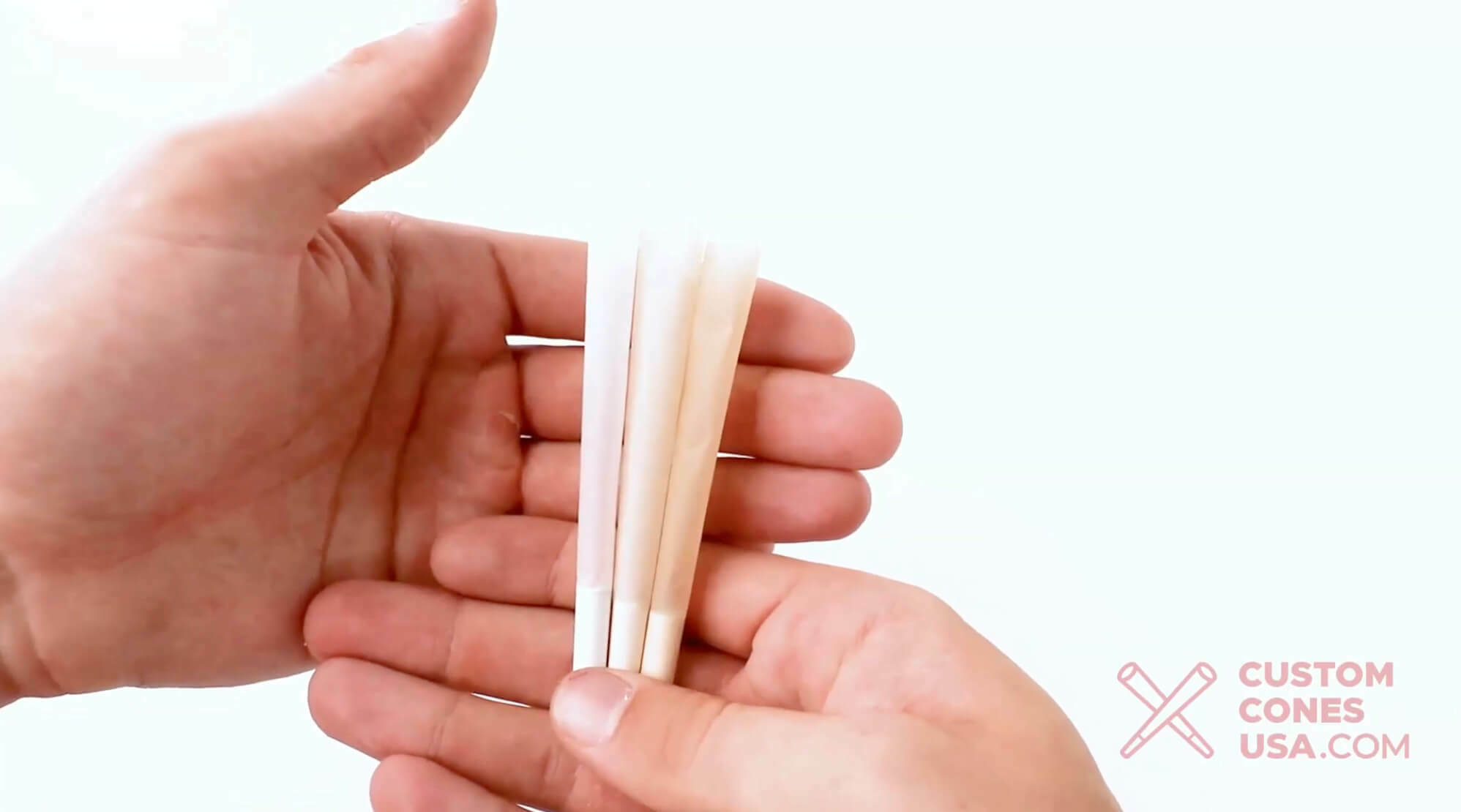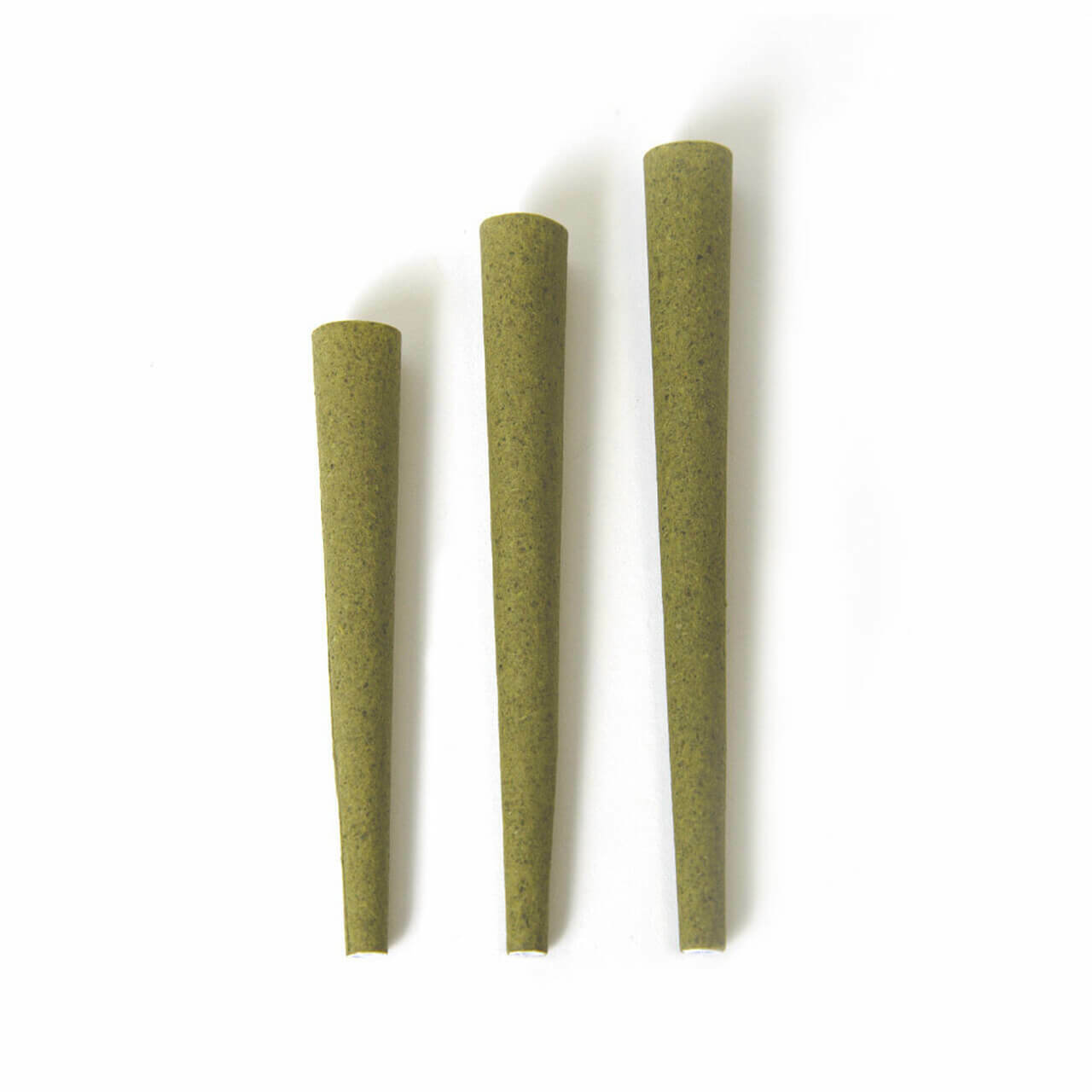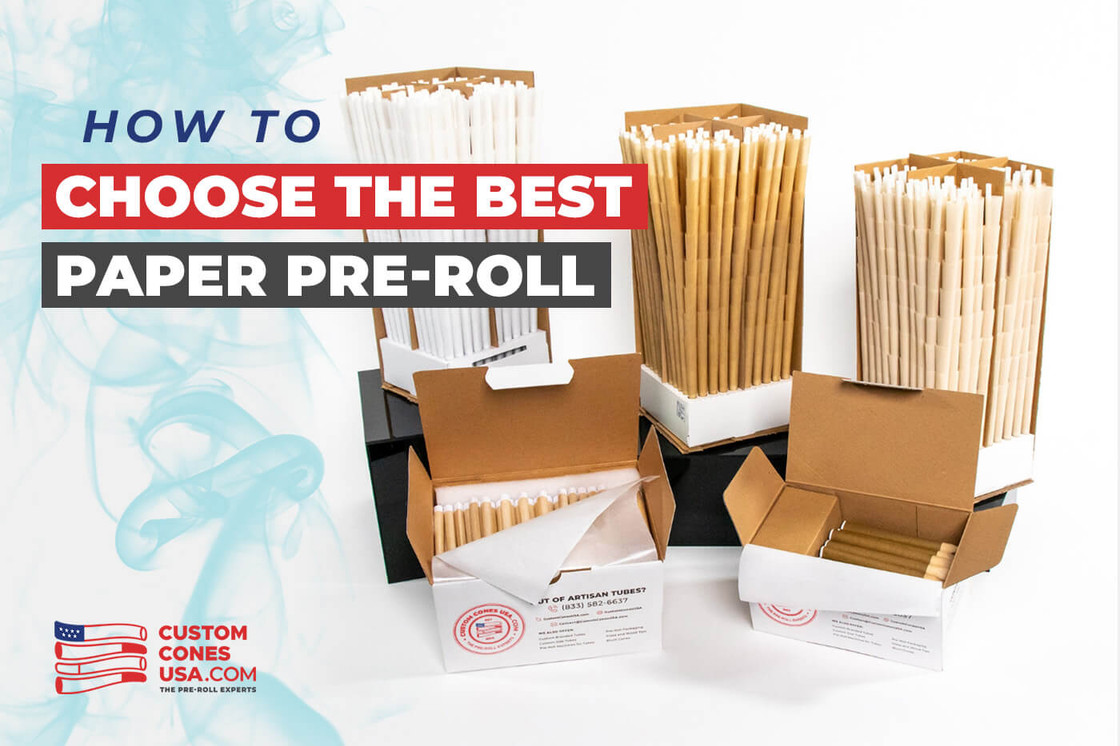How to Choose the Best Paper Pre-Roll
Posted by Custom Cones USA on Mar 28th 2024
What makes the perfect pre-roll?
There are many factors that weigh into a consumer's decision to purchase a pre-roll, from finding the right strain to selecting the ideal size for their smoke session.
For others, it’s all about the paper.
The type of paper in a pre-roll is an oft-overlooked component by businesses trying to cash in on the rise of pre-rolls as a product category. But as sales of pre-rolls continue to break records, it’s more important than ever to offer a variety of pre-roll options that align with consumer preferences.
But choosing the type of paper for your pre-roll line can be a daunting task, especially as consumer tastes change and new options emerge in the marketplace.
So we’re here to break it down. In this blog post, we’ll evaluate the types of rolling papers available for pre-rolled cones, walking you through the basics and facts you need before buying pre-rolls for your business. Let’s get started.
The Different Types of Paper Pre-Rolls
While there are seemingly endless methods to consume cannabis, from edibles to vapes and even beverages, the types of paper pre-rolls have remained remarkably consistent over the years.
As pre-rolls continue to grow in popularity, there is more data available about what people are smoking and which type of paper they prefer.
According to our recent white paper made with data sourced from Headset.io, the big three – white, brown, and hemp paper – blow the competition out of the water.
The numbers speak for themselves. It’s clear from the graph that producers prefer refined white, organic hemp, and natural brown papers, which are about twice as popular as other lesser-known paper types available on the market.
White paper remains the most popular pre-roll of choice. Although they are colloquially referred to as “rice paper,” it’s a common myth that these papers are made from edible rice paper. These pre-rolls are sourced from wood pulp refined to remove impurities.
White paper pre-roll cones and tubes are so refined that they no longer contain any plant components, save for the plant cellulose. The refining process is what gives the paper its distinct white color.
Brown paper pre-rolls are also sourced from wood pulp but have a few key differences from white paper pre-rolls. For one, they are less refined than their white counterparts – meaning that they contain more of their lignans from their original plant material. This is what gives the paper its brown color.

Many consumers believe that, because of the brown color, they’re more natural or even healthier. Despite their earthy aesthetic, brown paper pre-rolls are no more natural than white paper pre-rolls.
But while brown pre-rolls are similar in makeup to white pre-rolls, consumers note that brown pre-rolls have a slower and smoother burn. They’re also a bit thicker, making them a good fit for anyone looking for strong rolling paper.
Another popular paper for pre-rolls is hemp paper. Hemp paper comes from hemp fibers made with sustainable or organic hemp. Because of its environmentally friendly growth method, hemp paper pre-rolls are a favorite among green or eco-conscious consumers.
Hemp papers are also renowned for their enhanced smoke experience. Pre-rolled cones and tubes made with hemp paper generally burn slower, which makes for a longer smoke session that allows smokers to savor and enjoy their pre-roll for extended periods of time.
Differences in Opacity
To see or not to see, that is the question. One of the major differences in paper pre-rolls is their opaqueness.
It’s no surprise that white refined paper pre-rolls are the most transparent, allowing customers to see through the paper and look directly at the flower inside the joint.
It may seem counterintuitive, but brown paper pre-rolls are more transparent than organic hemp pre-rolls even though they have a darker shade.
From a customer standpoint, the opaqueness of the pre-roll is a personal preference. But for cannabis companies, it’s a matter of compliance. Many states have strict regulations regarding the transparency of any cannabis packaging. While these laws don’t apply to the pre-roll paper, it’s worth considering how transparent or opaque your packaging needs to be when considering the type of paper you want to use for your products.
Flavor of Paper Pre-Rolls

Flavor is a key element that drives the popularity of pre-roll papers. But what flavor profile do the major paper types have and what sort of flavor can your customers expect?
As mentioned, white pre-roll paper has the least amount of plant components due to the refining process. The result? A smooth and enhanced smoking experience with little to no added taste, leaving only the flavor of the flower behind. This is ideal for customers who want to enjoy a smoke session that brings the unaltered taste of the cannabis to the forefront.
Although brown paper and white paper pre-rolls both derive from wood pulp, they do have slightly different tastes. Brown paper pre-rolls contain more plant material and thus have a bit more of a natural taste.
Aside from its small ecological footprint, hemp papers are renowned for having a stronger earthy taste. Of the three most popular paper types, hemp paper has the most distinct taste.
The flavor is easier to taste because of the long fibers in the hemp, which leave behind a distinct flavor that attracts those seeking a different taste that enhances their experience.
How to Evaluate Rolling Papers
If you’re looking to get into the paper pre-roll business, you’ll want to know how to evaluate what you’re buying. So, let’s take a closer look at the makeup of paper pre-rolls – how they’re measured, what’s in them, and what to look for to ensure you get the best bang for your buck.
It may surprise you that rolling paper isn’t measured in thickness, but rather in its basis weight. The basis weight is measured in GSM – which stands for grams per square meter. GSM is a measure of how heavy paper is, which is important in the consumer's experience.
The heavier the paper is, the more paper the customer consumes. Heavy paper makes for a harsher smoking experience. But you want to be careful not to use paper that is too thin as this increases the risk of canoeing.
A good rule of thumb is to use paper with a GSM rating between 12 and 15. Papers in this GSM strike the right balance between offering a smooth smoke experience and a limited risk of canoeing. All of our pre-rolled cones use 14 GSM paper, offering a smooth and reliable experience for your customers.
GSM isn’t the only way to measure the quality of rolling papers. You’ll also want to pay attention to the tensile strength, which measures the strength of fibers in the paper, and their resistance to tearing and punctures.
The porosity, or how much air can pass through the paper, of the paper will also impact the smoking experience. Papers with larger sized openings (or pores) burn faster due to an increased static burn rate. Speak with your manufacturer to understand more about the makeup of their rolling papers and how they will burn.
Additives in Rolling Papers
Another factor that will impact how well your rolling papers burn is whether they contain additives. High quality rolling papers will be additive free, which protects consumers from inhaling harmful chemicals when smoking.
A common additive found in rolling paper is calcium carbonate, otherwise known as chalk. Paper manufacturers add this additive to bleach their rolling papers, which become highly porous in the process. This impacts the burn, making the pre-rolls highly irritating to the lungs as well as eyes and skin. Rolling papers sometimes contains other chemicals such as titanium oxide to control their burn rate.
Additionally, a recent study revealed that 90 percent of rolling papers contain harmful heavy metals including arsenic, mercury, cadmium, lead, and pesticides. The study notes that 8 percent of papers contain at least one heavy metal in concentrations above the allowable limit in California for inhalable cannabis products.
Rolling papers are not regulated to the same degree as cannabis, and many manufacturers include additives that would not otherwise be allowed inside the actual product. Any additives pose a health risk when inhaled, so it's best to check with your manufacturer to determine whether they put additives in their products.
Here are Custom Cones USA, we rigorously test our papers and all of our products so they hold up against even the strictest standards. Our pre-rolled cones are compliant with California’s strict Phase Three testing and Canada’s compliance standards for pesticides, heavy metals, and microbials. We’re constantly testing our products to produce only the highest quality experience for both producers and consumers.
What about Pink Rolling Papers?
Pink rolling papers have grown in popularity in recent years thanks to their distinct color and unique experience for consumers.
Although the color may be alluring for customers hungry for new types of pre-rolls, these rolling papers pose a significant health threat. Pink rolling papers get their color from dye that contains coal tar, a substance that’s banned by the FDA for use in food and is harmful when consumed. To protect our customers, we do not sell any pink rolling paper products made with coal tar.
But there are alternatives if you’re looking to jump on the pink rolling paper trend. We sell pink printed papers that use soy-based dyes. Each printed paper is tested carefully for harmful additives, so you can rest easy knowing that your customers will be safe when lighting up. We also have pink tip pre-rolled cones, which offer the same color profile without the health risks of other pink pre-rolls.
Hemp Wrap Pre-Rolls

There’s another popular pre-roll that we have yet to discuss: hemp wrap.
Hemp wraps provide a strong structure and flavor that are more reminiscent of a blunt than a joint. The best part? They don’t have the same harmful effects of a blunt, which is typically made with cigar casing and contain tobacco.
For consumers looking for a tobacco-free alternative that offers a similar experience to smoking a blunt, hemp wrap pre-rolls are a fantastic option.
Hemp wraps are thicker and more flavorful than your typical paper pre-roll. Comprised of sturdy hemp cellulose fibers, hemp wrap blunts have a low chance of tearing or breaking.
We offer both classic hemp wrap blunts as well as hybrid hemp wraps. Our hemp wrap blunts are made with all-natural hemp sourced from Europe. They are free of any added dyes or chemicals but contain the look and feel of a traditional blunt. Our hybrid hemp wraps are a combination of paper and hemp, which creates a smooth and consistent burn and a long-lasting product that doesn’t dry out easily.
Your Paper Pre-Rolls
The type of paper is an important but oft overlooked factor that weighs into smokers’ decision when selecting a pre-roll.
Offering all the big three papers – white, brown, and hemp paper – will give you the best chance of offering pre–rolls matching consumer preference. Alternatives such as hemp wraps and colored pre-rolled cones are also available to help you diversify your product base.
While they have many similarities, each type of paper offers unique components that impact the overall smoke experience. The subtle differences in transparency, taste, and type of burn that each paper offers may make or break a smoker’s buying decision when they’re considering purchasing a pre-roll.
If you’re looking for quality paper pre-rolls that are free of harmful additives and tested to match the most rigorous standards in the cannabis industry, we’ve got you covered. Browse our catalog of paper pre-roll cones and tubes today to find the option that’s right for you.
What makes the perfect pre-roll? There are many factors that weigh into a consumer's decision to purchase a pre-roll, from finding the right strain to selecting the ideal size for their smoke session.


